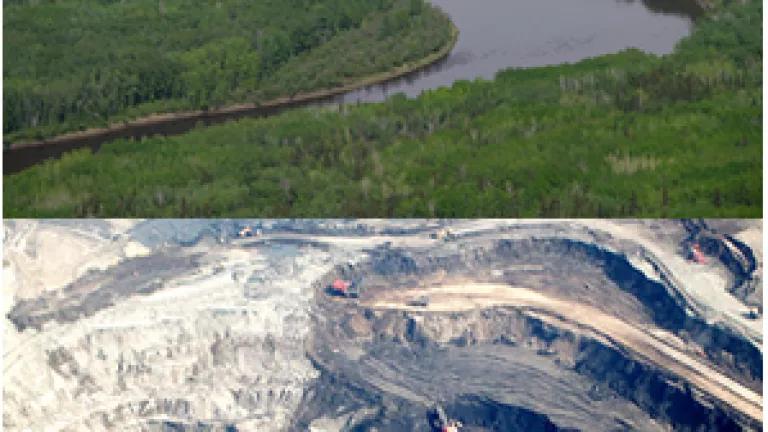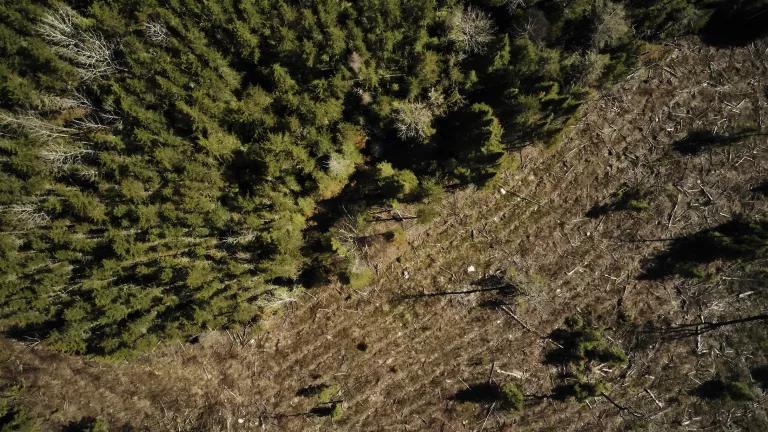
Tar sands oil mining causes more carbon pollution than previously estimated – according to a new study. This study reaffirms how bad of an investment the Keystone XL tax sands pipeline would be for our children, our country, and our future. Approving the Keystone XL pipeline will lead to more carbon pollution into the atmosphere – the kind of pollution which damages human health and scientists from around the world are documenting will lead to more extreme weather. Since Keystone XL pipeline is a gateway drug to further expansion of tar sands, halting the Keystone XL pipeline will make an important contribution in efforts to slow global warming.
A new scientific study – Oil sands mining and reclamation cause massive loss of peatland – published in the Proceedings of the National Academy of Sciences has found that previous estimates of the damage from tar sands have significantly underestimated the impact. So here is how the numbers stack up for tar sands oil taking into account this new estimate and including estimates if open-pit mining were further expanded as envisioned. The global warming pollution from tar sands is two-fold: (1) extra energy used in extraction; and (2) damages to the Canadian boreal forest.
GLOBAL WARMING POLLUTION FROM ENERGY-USED IN EXTRACTION
Construction of the Keystone XL pipeline would lead to greater demand for tar sands oil. As this demand increases, more energy intensive methods would be needed to extract the oil. Compared to conventional oil, tar sands takes more energy to extract and refine, and therefore its production is three- to four-times more greenhouse gas intensive. At the same time, the tar sands industry has plans for even greater expansion.
Keystone XL Pipeline Will Lead to Increased Pollution. If the Keystone XL pipeline is completed and operating at its capacity, the project would increase carbon pollution by 27 million tons of CO2 per year (according to the EPA).** This is the equivalent to the pollution from seven coal-fired power plants operating continuously or having 6.2 million cars on the road for 50 years.
Further Expansion is Envisioned, Driving Up the Tally. Tar sands operators have plans to expand tar sands even more which would lead to an additional 228 million tons of CO2 pollution annually***.
IMPACT OF TAR SANDS EXPANSION ON CANADIAN FORESTS AND PEATLAND
Approximately 20 percent of tar sands oil is extracted by open-pit mining which lays waste to millions of acres of carbon stored in the Boreal forest. To produce just one barrel of oil, these trees are felled, and tons of earth are scooped up by massive backhoes. This destroys the carbon stored in these carbon-rich forests and “contrary to claims made in the media, peatland destroyed by open-pit mining will not be restored”. This devastation directly releases carbon pollution and reduces the ability of the forests to store more carbon in the future. Both of these impacts are significant according to this new study.
Damages from Currently Approved Mines will be Significant. Currently, 10 open-pit mines have government approval to operate, covering about 412,000 acres. Tar sands mining at these locations will release between 42 and 173 million tons of CO2. And since the amount of carbon stored in these forests is increasing as the trees grow and the soil sequesters more carbon, this mining will reduce the amount of sequestered carbon by about 21–27,000 tons of CO2 per year.
More Open-Pit Mining is Under Lease which will Further Increase the Damage. Even more open-pit mining is under various stages of development. Tar sands deposits that are accessible by open-pit surface mining cover about 1.2 million acres of boreal forests in Alberta, Canada. About 99% of this area is currently under lease. So further expansion of open-pit mining could lead to even greater carbon losses and decreased sequestration. With this expansion the amount of carbon lost could increase to 119-493 million tons of CO2, using similar factors.**** And the amount of decreased sequestration from these forests would equal around 60-492,000 tons of CO2 per year.
KEYSTONE XL IS THE GATEWAY DRUG TO THIS DAMAGE
Keystone XL would lead to a large amount of pollution and would be the “gateway drug” to expanded tar sands production leading to more carbon pollution that is causing global warming. Building the Keystone XL pipeline would make expansion of tar sands oil mining possible as the tar sands operations are landlocked – they need a route to export the oil out of Alberta, Canada. There are current barriers that make exporting tar sands to overseas markets impossible in the near term and highly unlikely over the medium- to long-term without Keystone XL. Alternative pipelines to Canada’s West Coast are in the very early stages of the regulatory process. There is no commercial support for the Enbridge Northern Gateway pipeline and significant legal opposition has arisen from Canadian First Nations who have the legal ability to stop or significantly delay pipelines due to their constitutional rights. There is also significant public opposition to off shore tankers that would carry tar sands from the British Columbia coast.
As the global warming damage from tar sands expansion continues to stack-up, it reaffirms why the Keystone XL is such a bad investment for our children, our country, and our future.
-------------------
* Tar Sands Photos: The Athabasca River near Fort McMurray, Alberta, David Dodge, The Pembina Institute; and Oil sands mining, Chris Evans, The Pembina Institute, both courtesy of oilsandswatch.org.
** Metric tons is used throughout this post when “tons” is referenced.
*** Using the same calculations as EPA, the emissions created from producing this much tar sands compared with the equivalent amount of conventional oil would be 228 million metric tons of CO2 emissions annually.
**** This new study estimated that 41.8-173.4 million tons of CO2 were lost for conversion of 412,774 acres (167,044 ha). And they estimated that the lost carbon sequestration for this amount of land equaled 21,025–26,550 tons of CO2 per year. Assuming the same amount of lost carbon and decreased sequestration per acre in the currently planned area, the full amount of open-pit mining land available could lead to this damage. Expanded studies would need to look at the exact make-up of the expanded land area (e.g., does it have the same type of vegetation and carbon storage) and the carbon differential between the existing forest and the reclamation plans. These numbers are based upon the assumption that the land area is similar and that the reclamation plans would be the same.



